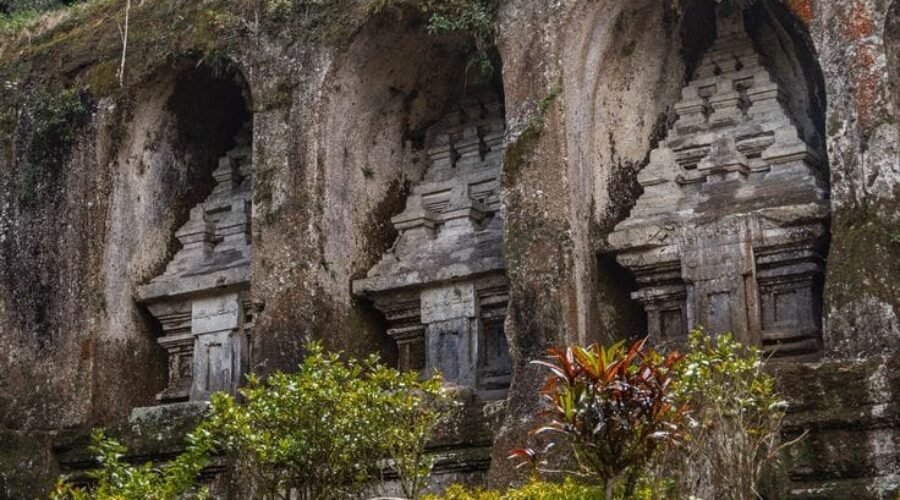Temple Gunung Kawi Bali: Discover Bali’s Iconic Gunung Kawi Temple Complex and Ancient Candis
When you think of Bali, images of serene landscapes, spiritual temples, and lush rice terraces often come to mind. Among the island’s countless cultural treasures, Temple Gunung Kawi Bali stands out as a gem steeped in history, mystery, and breathtaking beauty. Located near the village of Tampaksiring, this ancient temple complex is an architectural masterpiece and a spiritual haven that draws visitors seeking to explore Bali’s historical and religious heritage.
Let’s dive deep into the Temple Gunung Kawi Bali, a site where Balinese history, culture, and nature harmoniously converge.
The Historical Significance of Temple Gunung Kawi Bali
The origins of Temple Gunung Kawi Bali date back to the 11th century during the reign of King Anak Wungsu, son of the great King Udayana and Queen Mahendradatta. This temple complex is believed to have been constructed as a tribute to the royal family. The rock-cut candis, or shrines, symbolize the eternal resting place of the king, his concubines, and other members of the royal lineage.
Temple Gunung Kawi Bali is nestled in a tranquil river valley surrounded by rice fields, creating a serene atmosphere for visitors. The Pakerisan River, which flows alongside the temple grounds, plays a significant role in the spiritual essence of the site. The river is considered sacred, and its waters are often used for purification rituals at nearby temples, such as Tirta Empul.
One of the temple’s key features is its ancient tombs carved into the valley walls. These two rows of ancient royal tombs are architectural marvels, showcasing the ingenuity and artistry of ancient Balinese craftsmen. Each shrine was painstakingly cut out of the rock, forming a stunning blend of human craftsmanship and natural beauty.
Pura Gunung Kawi: The Heart of the Temple Complex
The heart of Temple Gunung Kawi Bali is Pura Gunung Kawi, a set of ten rock-cut candi monuments divided into two groups by the river. The east side features five shrines, while the west side houses the remaining five. These shrines are thought to honor different members of the royal family, including King Anak Wungsu and his queen.
The rock face carvings are intricate and awe-inspiring, symbolizing the dedication and skill required to create such a monumental site. The valley walls on both sides further enhance the grandeur of the location, making it a visual feast for visitors.
Exploring the Gunung Kawi Temple Complex
The Entrance and Stairs
Visitors to Temple Gunung Kawi Bali begin their journey with a walk down a staircase leading to the lush river valley running through the temple site. The descent is a scenic experience, surrounded by verdant rice fields and traditional Balinese architecture. Along the way, you’ll pass by stalls offering local souvenirs and refreshments, adding a touch of local flavor to your visit.
The stairs down to the valley are flanked by tropical greenery, setting the tone for the tranquil and spiritual experience that awaits. Once you reach the bottom, you’ll cross a small bridge over the Pakerisan River to enter the main temple grounds.
The Sacred Candis
The ten rock-cut candis are the highlight of the Gunung Kawi Temple Complex. Each candi is carved directly into the cliff face, standing tall as a testament to the island’s ancient architectural prowess. The solid rock monuments are believed to serve as memorials for the souls of ancient kings and their families.
It is believed that each temple served a unique purpose within the complex, whether as a resting place, a site of worship, or a spiritual symbol. The craftsmanship of these monuments is truly remarkable, with detailed carvings that reflect the artistic excellence of the ancient Balinese.
The Spiritual Significance of Gunung Kawi Temple in Bali
Temple Gunung Kawi Bali is not just a historical site but also a deeply spiritual one. The temple grounds are considered sacred, and visitors are required to wear a sarong as a sign of respect. Sarongs are usually available at the entrance for those who don’t bring their own.
The temple’s location in a river valley surrounded by nature creates an atmosphere of serenity and contemplation. The gentle flow of the Pakerisan River, combined with the natural beauty of the valley walls, enhances the sense of spirituality and connection to nature. The site is also connected to Tirta Empul, a nearby sacred water temple, which is known for its holy springs and purification rituals.
Visiting Gunung Kawi: What You Need to Know
Entrance Fee and Accessibility
To visit Gunung Kawi Temple, you’ll need to pay an entrance fee, which is relatively affordable. The fee helps maintain the site and ensures its preservation for future generations. The entrance ticket includes access to the entire temple complex, including the main shrines, meditation areas, and smaller candis scattered around the site.
The temple is located just a short drive from Ubud, making it an easy addition to your itinerary if you’re exploring the Tampaksiring region. The journey to the temple offers scenic views of rice fields and traditional Balinese villages, adding to the overall experience.
According to Indonesia Travel, the temple complex is super easy to reach, just a few hundred meters east of the main Jalan Raya Tampaksiring road. From there, you’ll walk down a paved pathway lined with cute art shops and cozy local warungs. As you descend around 300 steps toward the river, you’ll be greeted by lush rice terraces and stunning green valleys that feel like a trip back in time. At the bottom, you’ll pass through a stone archway with small pillars holding earthen vases of holy water—don’t forget to sprinkle some on yourself before stepping into the complex!
When to Visit
The best time to visit Temple Gunung Kawi Bali is early in the morning or late afternoon. These times offer cooler temperatures and fewer crowds, allowing you to fully appreciate the tranquility of the site. Taking your time to explore the temple’s nooks and crannies will reward you with a deeper understanding of its history and significance.
Legends and Myths Surrounding Gunung Kawi Temple Complex
Gunung Kawi Temple Complex is steeped in ancient legends. One popular myth is that the giant Kebo Iwo carved the candis in a single night. Whether fact or folklore, this story adds an element of mystery and wonder to the site, highlighting the spiritual and cultural significance of Temple Gunung Kawi Bali.
The temple is often referred to as the valley of the kings, symbolizing its connection to Bali’s royal lineage. It is said that the rows of ancient royal tombs were designed to provide a place of eternal rest for the souls of ancient kings and their families.
Exploring the Surrounding Area
Gunung Kawi Temple in Keliki Countryside offers more than just historical and spiritual experiences. The surrounding area is dotted with beautiful rice fields, traditional Balinese villages, and other notable landmarks such as Pura Samuan Tiga and Pura Mangening, which was recently renovated. These sites provide additional opportunities to explore Bali’s rich culture and heritage.
Visitors can also take a leisurely walk along the lush river valley running through the temple site, enjoying the peaceful ambiance and natural beauty. The valley walls on both sides create a sense of enclosure and intimacy, making the experience even more special.
The Unique Architecture of Gunung Kawi Temple Bali
The architecture of Temple Gunung Kawi Bali is a stunning example of ancient Balinese ingenuity. The candis are carved directly into the solid rock, blending seamlessly with the natural surroundings. The valley walls provide a dramatic backdrop, while the cliff face carvings showcase the artistic skills of the era.
Each candi is uniquely designed, reflecting the individuality of the person it honors. The temple site also features smaller shrines, courtyards, and meditation niches that add to its charm and complexity. The overall layout of the temple grounds is both functional and symbolic, emphasizing the connection between the physical and spiritual worlds.
Conclusion: Why You Should Visit Temple Gunung Kawi Bali
Visiting Temple Gunung Kawi Bali is more than just a sightseeing experience; it’s a journey into the heart of Balinese culture, history, and spirituality. From the intricately carved candis to the serene river valley surrounded by rice fields, every aspect of the temple exudes beauty and significance.
Whether you’re drawn to the site’s ancient legends, its role in Balinese history, or its stunning natural setting, Temple Gunung Kawi Bali offers something for everyone. So take your time, explore the temple grounds, and immerse yourself in the timeless beauty of one of Bali’s most cherished landmarks.
By visiting this iconic temple site, you not only witness a piece of Bali’s past but also gain a deeper appreciation for its enduring culture and traditions. Don’t forget to wear a sarong, respect the sacredness of the site, and enjoy your journey into the magical world of Temple Gunung Kawi Bali.
Read more: 10 Interesting Facts About Bali: Fascinating Insights Into the Island of the Gods



